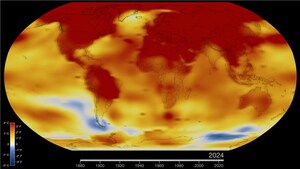WASHINGTON, Nov. 16, 2020 /PRNewswire/ -- From assessing COVID-19's global impacts to helping NASA return humans to the Moon to searching the cosmos for new exoplanets, researchers from across NASA, with university and industry partners, will highlight their latest advances, enabled by the agency's supercomputers, in the NASA research exhibit at SC20—the International Conference for High Performance Computing, Networking, Storage and Analysis. This year, the conference is being held virtually November 9 through 19, 2020.
The virtual NASA exhibit will feature 35 science and engineering projects for which HPC plays an essential role.
This year, as a participant in the national COVID-19 High Performance Computing (HPC) Consortium, an interagency effort organized by the White House Office of Science and Technology Policy, NASA is donating supercomputing resources and services to four projects that are investigating the coronavirus's genetic make-up, human cellular response, and development of treatments. In addition, NASA Earth science researchers are also calculating global impacts of COVID-19 restrictions, such as changes in atmospheric carbon dioxide as measured by NASA's Orbiting Carbon Observatory-2 (OCO-2) and a decline in air pollution detected by monitoring sites worldwide.
The exhibit also highlights the critical role of NASA's HPC resources in research projects across the agency. For example:
- Successful prediction of jet acoustics supported the engineers designing NASA's X-59 supersonic concept aircraft in reducing ground-level noise, with the goal of enabling aircraft to fly faster than sound without producing sonic booms.
- For NASA's Artemis Program of human lunar exploration, simulation results of thousands of Space Launch System (SLS) solid-rocket booster separation scenarios – along with simulations to accurately predict the acoustic vibrations on the surface of the Orion crew vehicle's Launch Abort System – are critical in reducing risk to astronauts on board Artemis II, the mission's first crewed flight test.
- Rapid turnaround simulations of the launch environment at NASA's Kennedy Space Center have provided design engineers with data on how hot plume gases and strong acoustic waves during ignition of the SLS rocket engine will impact the launch structure, leading to a safer and more robust design.
- Farther out in space, scientists are using NASA HPC and machine learning resources to analyze data from the agency's Transiting Exoplanet Survey Satellite (TESS)—enabling the discovery of more than 80 exoplanets and more than 2,000 planet candidates as well as more than 450,000 multiple-star systems, so far.
NASA's on-line exhibit includes content contributed by scientists, engineers and technologists from across the U.S., including NASA's Ames Research Center in California's Silicon Valley, NASA's Goddard Space Flight Center in Greenbelt, Md, NASA's Langley Research Center in Hampton, Virginia, and university partners.
In addition to the exhibit, NASA Goddard scientist Compton Tucker will present an Invited Talk, "Satellite Tree Enumeration Outside of Forests at the Fifty Centimeter Scale," on Tuesday, November 17. Several other agency researchers are also presenting in a variety of SC20 program sessions.
Media interested in conducting interviews should contact Alison Hawkes at [email protected]/650-604-4789 or Rob Gutro at [email protected]/301-286-4044.
For more information about NASA's participation at SC20, visit: https://www.nas.nasa.gov/sc20
For the SC20 Virtual Event FAQs, visit: https://sc20.supercomputing.org/attend/virtual-event-faq/
For more information about SC20, visit: https://sc20.supercomputing.org
SOURCE NASA

Related Links
WANT YOUR COMPANY'S NEWS FEATURED ON PRNEWSWIRE.COM?
Newsrooms &
Influencers
Digital Media
Outlets
Journalists
Opted In






Share this article